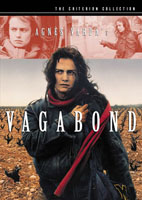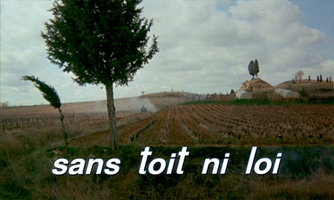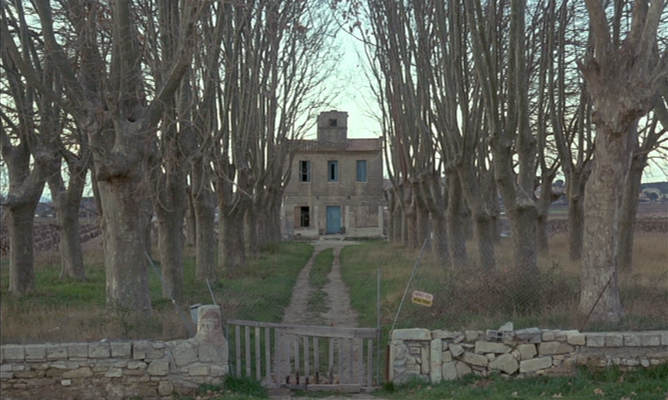2000:  2008:
2008: 

written and directed by Agnès Varda
Criterion #74: Vagabond.
(As last time: the current edition exists only as a component of boxset #418 “Four by Varda,” but it retains the original spine number 74.)
I have in the past used this space to express skepticism about the way titles are translated, but in this case the non-parallel English title is justified. Firstly: because I get the impression Agnès Varda chose it, and she’s entitled to choose whatever she likes. Secondly: because the French title (“Without Roof or Law”) is a play on a French expression, sans foi ni loi (“without faith or law”) which is just a stock phrase meaning ruthless/lawless/unscrupulous. Since there’s no way of translating the wordplay, there’s no way of translating the title.
Furthermore, Vagabond is a fine title.
Another art movie with integrity from Agnès Varda. The atmosphere and subject matter are entirely different from Cléo, at least superficially — the film stock and the era are 20 years removed, so the movie is made of a whole other sort of “stuff” — but the underlying attitude is recognizably the same. To me that indicates that the art is working: I could tell this was another communique from the same mind, without her having to insert any self-conscious signals (“It’s me again, so here’s my ‘style’!”).
The construction is very simple: there is a psychologically opaque person at the center, and then in orbit around her are various people going about their lives, occasionally affected by her gravity, as she is occasionally affected by them. We are invited simply to watch, and to wonder what to make of the life we are watching. This is the same as wondering what manner of thing a person is. The protagonist, Mona, is a drifter with no attachments and no apparent objective — her personal freedom of action is nearly absolute — so existential reflections become quite natural. What exactly is this business that she’s engaged in, this business of staying alive?
One of the intriguing peculiarities of this movie is that it begins with the discovery of Mona’s dead body, and then the rest is presented in a pseudo-investigative/documentary retrospect, where sometimes the various other characters comment directly to the camera about their encounters with her. Naturally, this imparts a certain underlying sense of urgency, tragedy, and even mystery to the whole film — we can’t help but want to know: how exactly will she end up freezing to death in a ditch? Varda has identified the device as being knowingly borrowed from Citizen Kane. It’s worth noting that, exactly as in Citizen Kane, the mystery-story frame doesn’t determine the spirit of the work; in fact, it actually relieves the material of the ordinary narrative burdens it would otherwise bear, and lets it speak more genuinely as itself, which is to say more ambiguously. The forensic attitude is a handy shortcut to a philosophic attitude, a trick that works on audiences that might otherwise not be inclined to approach things philosophically.
In fact I think this might be the secret appeal of all mystery stories: the rigid puzzle machinery so completely obviates any dependence on the “soft” tensions of standard narrative that all such human things are freed to appear in a philosophical light, in all their potential richness. That’s why Sam Spade’s musings about dames feel so full of juice: because the audience is 100% certain that they’re not load-bearing.
I said the subject matter was entirely unlike Cléo From 5 to 7, but from a certain point of view it’s actually very much the same: a woman walks (and is driven) from place to place, passing through a series of episodes and encounters, while the specter of death hangs over her. She is alone, then acquires companions, then is alone again, etc. An imposed formal scheme (the realtime clock in Cléo; the foreordained doom in Vagabond, as well as the recurring tracking shots with abstract music) contains her journey but does not define it.
I want to note that this very rich and flexible framework, shared by these two movies, is essentially the Alice in Wonderland framework, which has always meant a lot to me. One of the loveliest things about the Alice books is that the “specter of death” element is thoroughly soft-pedaled, hardly spoken at all, and yet still remains unmistakably present — I think because it is simply an existential reality of this particular dream-configuration. Over here is joy, and here in the center is the absurd, and over here is fear. They must necessarily all be present. As they are in both of these movies.
A thing that particularly struck me about Vagabond while I was watching was the fact that the various characters who populate Mona’s journey keep recurring and interacting with each other; they comprise their own little system of relationships and intrigues. So while Mona’s progress is inescapably, doomedly linear, the space around her is not, or at least not entirely. It loops back on itself, alive in its own way. This is also true of Alice: some of the most fascinating moments in those books are when characters who seem immutably fixed, each within their own wacky tableau, incongruously reappear later in other contexts (e.g. the Mad Hatter showing up in the courtroom to give evidence), as though to imply that there is a coherent social and geographical reality that functions even beyond Alice’s field of vision. Quite obviously there isn’t. But there is something, some principle of existence that operates without her, even in her own dream.
Mona’s gravity well at the center of her movie creates a similar bent-space effect: life in Vagabond doesn’t really go on without her, and yet it makes a point of demonstrating that it does, to the point of absurdity: when the student of the professor turns out to be the nephew of the old woman, the needless coincidence creates, if anything, the feeling that the interconnectedness of the people around Mona is from her perspective a supernatural phenomenon, a narrative dream-logic like Alice’s, to be understood in the same spirit. The world around Mona, with which she is only ever partially engaged, is not merely a world, it is the very principle of “a world,” condensed.
I took the tracking shots with music to be the “truth” of Mona’s existence, a kind of meaning that stands outside of the kind of pat interpersonal projections that construct her in the eyes of the other characters. She isn’t comfortable being with people because this tracking-shot essence of life is not compatible with them, nor is this undeclarative, frequently untonal music that represents the emotion of her truth. The way the music always ends abruptly on a cut is like a snapping-to, a loss of grace as the scene of the next human encounter organizes itself and Mona prepares once again to become an object of someone else’s story.
In her brief establishing voice-over at the beginning, Varda says she likes to imagine that Mona emerged from the sea. But it is made explicit later that Mona has had a real non-mythical background, used to have a secretarial job before she fled from her life. I take the narrator’s flight of fancy as a kind of performance of her own equal culpability in mythologizing and projecting; an acknowledgement that even this movie, about the silent core of a person that exists beyond projection, is a kind of projection. It has to be; it’s a work of art, it’s fiction, it’s public. There’s no way around it. But it knows what it is, and doesn’t make grandiose claims about what it’s accomplishing. The director’s control is both loose enough and precise enough that we understand that what we’re seeing is a process of consideration, of musing and observing, not an assertion of anything in particular.
I suppose I sound enthusiastic. I’m certainly being sincere in taking the film seriously. I admired it and found it stimulating. Nonetheless when it came time to tell Netflix how many stars it was worth in my book — a time that inevitably comes for every movie — I only gave it three, not the four that perhaps are here implied. So a note about why: the movie’s integrity was almost too great for me to be “moved” by what I saw. I felt I was in good company, worthy company, but neutral company at some basic spiritual level. I didn’t feel oppressed, but I also didn’t feel ennobled. I just felt life-y stuff. Take that as high praise for Agnès Varda. But it’s not the same thing as enthusiasm. I guess I reserve that fourth star for some degree of enthusiasm.
I felt more enthusiasm, I think, for the extras, where once again Agnès Varda has assembled her own little memoiristic bonus featurette-and-a-half with great warmth and charm. As I’ve said repeatedly, art is a social encounter, and Vagabond is very deliberately a social encounter with a moral and emotional neutral being, a Rorschach person. A Rorschach test can be interesting to undergo but it gives nothing; I could only come away with myself as I already had been, and with the neutrality I had been offered. Whereas Ms. Varda is a positive person and from her behind-the-scenes chitchat I felt I came away having been given something positive.
Am I really so dependent on others for my emotional experiences? No, not in life, not ideally; but when watching a movie, yeah, I guess. Isn’t that kind of the point?
I’ll grant that it’s often the case that this kind of bold, well-made Rorschach film turns out to be a long-term inflater (i.e. in my estimation, vs. a deflater; this is an old scheme of mine for talking about the afterlives of artgoing experiences). But only time will tell.
Connection to the preceding movie: I’ve already outlined major ones, not to mention the obvious credit continuity. I guess something really fleeting and superficial might be in order too. Fine. The protagonist walks into a cafe where she doesn’t know anybody and starts a song on the jukebox.
Music is by Joanna Bruzdowicz, a Polish composer who would go on to do several more collaborations with Varda. In this case the score is founded on a pre-existing classical composition, the second movement of Bruzdowicz’s String Quartet No. 1 “La Vita” (1973/83), which Varda heard and then asked Bruzdowicz to expand upon for the movie. The atmosphere it creates is of expressionism that has been allowed to develop freely in a purely conceptual space until it is nearly abstract, especially in relation to the noncommittal imagery of simply trudging across fields and roads. The immediate connotation is “high concert music,” but the juxtaposition with the completely earthy subject matter creates, as I said above, an impression of a kind of truth beyond mere drama. Unfortunately the music on its own isn’t anything special, at least to my ears. But that’s fine. It’s only “nothing special” within its own musical tradition, which is one that’s almost never heard in movies. So that makes it special after all.
Here’s our selection, the Main Titles:
We just upgraded WordPress, and now I suddenly I can embed this convenient music player. Pretty great, right?

We just upgraded WordPress, and now I suddenly I can embed this convenient music player. Pretty great, right?
YES!